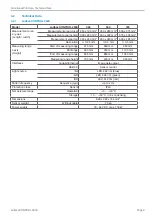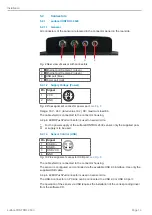
Page 21
Operation of the Sensor
surfaceCONTROL 2500
6.5.2
Calibration
The calibration of the sensor serves to determine the orientation of the camera coordi-
nates in the coordinate system of the inspection system and is carried out with the aid of
a pre-calibrated calibration field.
The sensor is factory calibrated upon delivery. An acceptance report is included with
each sensor and the necessary calibration data for the use of the sensor are provided on
a separate CD.
When the sensor is operated under frequently and strongly changing ambient condi-
tions, a new calibration of the sensor can be necessary at the beginning of a series of
measurements. This also applies after transport or strong vibrations of the sensor.
The sensor is calibrated using the dimensionCONTROL CameraCalibration software.
For further information and instructions for carrying out a calibration, see the operating
instructions surfaceCONTROL 2500-500 Camera Calibration 4.1.
6.5.3
Positioning of Sensor and Test Object
i
Note the following instructions for optimal positioning of the sensor to the test ob-
ject:
Observe an optimum distance between the sensor and the surface of the test object
according the Technical Data
1
.
Align the sensor with predominantly diffusely reflecting surfaces as perpendicular to
the surface as possible.
In the case of partially glossy surfaces, reflections from the test object can be reduced by
inclining the sensor by up to 30° with respect to the surface of the test object.
If the test object contains design edges, the sensor should be aligned as horizontally as
possible to these.
The positioning of the sensor to the test object can be supported by means of the sur-
faceCONTROL Defmap3D software.
Please refer to the corresponding instructions in the operating instructions of the
software.
6.6
Error Influences
6.6.1
Reflection Factor of the Surface of the Target
The sensor evaluates the diffuse portion of the reflected light. Any statement about a
minimum reflection factor is only possible with reservations. A preliminary examination is
necessary for using the sensor on reflective or highly reflective objects.
6.6.2
Color Differences
Color differences between test objects result in apparent changes of the surface texture
of the test object and thus also influence the calculation of the 3D data from the acquired
images. Therefore color differences can result in increased measurement inaccuracies
and reduced detection performance.
As the exposure parameters can only be changed as a whole, careful matching of the
exposure to the target surface is recommended.
6.6.3
Temperature Influences
When the sensor is commissioned a warm-up time of at least 30 minutes is required to
achieve uniform temperature distribution in the sensor. Large temperature fluctuations
and changes of the ambient climate act directly on the sensor and its fixing elements and
can thus change the detection performance.
i
It is recommended to operate the sensor under as constant as possible ambient
conditions. A new calibration is required if the ambient conditions change perma-
nently.
1) Optimum distance is the mid of measuring range.




















